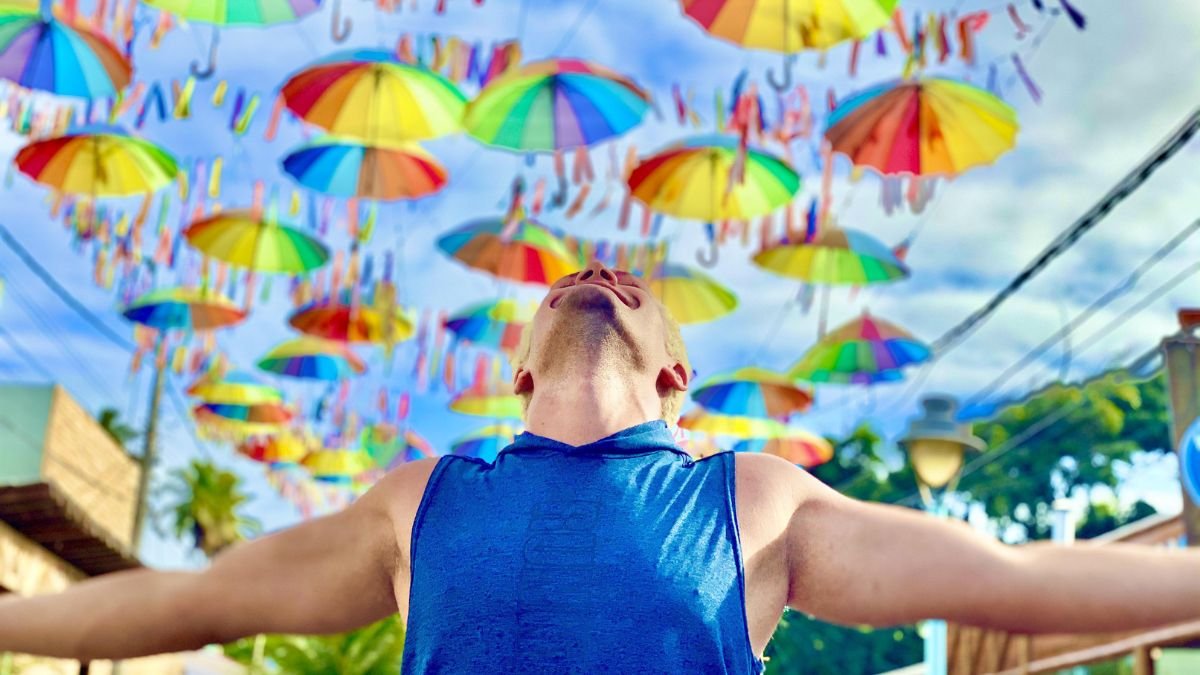Introduction
The Brazilian lifestyle is more than a way of life — it’s a celebration of joy that captivates the world.
Ever wondered why this South American nation is often ranked among the happiest places on Earth? From vibrant festivals that fill the streets with color and music to breathtaking landscapes that inspire awe, the people here have mastered the art of celebrating life in ways that captivate the world.
The lively rhythms of samba echo through the air, and the infectious laughter during local gatherings showcases a spirit of joy that is deeply ingrained in their samba culture.
This vibrant Brazil lifestyle is reflected in each festival, which is not just an event; it’s a heartfelt expression of community and tradition, bringing people together in a harmonious celebration of existence.

The country’s rich cultural tapestry blends indigenous roots, African influences, and European traditions. UNESCO-recognized carnivals, rhythmic samba beats, and a coastline stretching over 7,000 kilometers create an irresistible energy.
But it’s not just about parties. The balance between work and leisure, deep social connections, and appreciation for nature make this place unique. Let’s explore what makes their approach to living so extraordinary.
Key Takeaways
- Brazil ranks among the world’s most joyful cultures
- Music and dance are deeply embedded in daily life, reflecting the vibrant samba culture
- UNESCO recognizes multiple local festivals
- The Amazon covers 60% of the territory
- Coffee production shapes economic traditions
1. Brazilian Music and Dance: A Lifestyle Fueled by Rhythm
Few cultures express joy through rhythm as vividly as this musical powerhouse. From bustling cities to coastal regions, every street corner pulses with melodies that invite movement and connection, reflecting the rich samba culture.
The vibrant sounds of Brazilian music are not just entertainment; they are a reflection of the country’s diverse heritage and communal spirit, weaving together the stories and experiences of its people.
Samba: The Heartbeat of a Nation
Born in Bahia’s capoeira circles, samba blends African percussion with indigenous storytelling. Today, it fuels Rio Carnival, where 700+ samba schools compete in dazzling parades, showcasing elaborate floats and stunning costumes that celebrate samba culture and Brazilian culture.
The samba-enredo—a narrative style—turns each performance into a living history lesson, allowing audiences to experience the rich tapestry of Brazil’s past and present. Samba is more than just a dance; it embodies the spirit of resilience and joy, connecting generations through its infectious rhythms, all while celebrating the vibrant samba culture.
Bossa Nova and Beyond: A Musical Melting Pot
In the 1950s, Rio’s Beco das Garrafas clubs birthed bossa nova, a jazz-infused revolution. Tom Jobim’s collaborations with Frank Sinatra, such as “The Girl from Ipanema” (covered over 5 million times), made it a global hit. Modern artists, such as Marisa Monte, a 2023 Latin Grammy winner, continue to innovate.
Salvador, with its 85% African-descendant population, spins out axé beats, while Pernambuco’s frevo and the Northeast’s forró prove diversity thrives. Explore more about these musical traditions that turn every day into a celebration.
2. Brazilian Lifestyle: A Celebration of Cultural Diversity
With over 300 ethnic groups, this nation thrives on cultural fusion unlike anywhere else. Nearly 275 languages echo through its streets, from the Amazon rainforest to bustling urban centers.
This blend creates a living mosaic where every tradition finds its place, showcasing a vibrant tapestry of customs, beliefs, and practices that reflect the country’s rich history, including its renowned samba culture. Each ethnic group contributes its unique flavors, whether through food, music, or festivals, creating a dynamic cultural landscape that is constantly evolving.
Brazil is home to over 300 ethnic groups and nearly 275 spoken languages, creating a cultural mosaic found nowhere else in the world. From the Amazon rainforest to São Paulo’s Japanese neighborhoods, this diversity weaves together a vibrant, living heritage. For a deeper understanding of Brazil’s rich ethnic composition and how it shaped the nation’s identity, explore this comprehensive guide on Brazil’s ethnic groups from Britannica.
Indigenous, African, and European Influences
The Tupi-Guarani language gifted Portuguese 20,000 words, like abacaxi (pineapple). In Salvador’s Pelourinho district, Afro-Brazilian Candomblé rituals mix religion with rhythmic drumming—a legacy of West African traditions.
These rituals serve not only as a means of spiritual expression but also as a celebration of African heritage, blending elements of African deities with Catholic saints, thereby illustrating the syncretic nature of Brazilian culture. The vibrant ceremonies often feature elaborate costumes, intricate dances, and powerful music that resonate with the community, fostering a sense of identity and belonging among participants.
German immigrants shaped Pomerode, a charming town where 89% of residents boast European ancestry, particularly from Germany. This strong German influence is evident in the town’s architecture, characterized by picturesque half-timbered houses that resemble those found in Bavaria, creating a unique aesthetic that appeals to both tourists and locals.
The annual Oktoberfest celebrations here are a vibrant homage to German culture, drawing in around 500,000 attendees who come together to enjoy traditional polka music, authentic German cuisine, and, of course, a wide variety of beers. Meanwhile, São Paulo’s Liberdade district is home to 1.9 million Japanese descendants—the largest diaspora outside Japan—where their rich cultural heritage is celebrated through various festivals, markets, and culinary delights that showcase the fusion of Japanese and Brazilian traditions.
Festivals That Unite the Nation
The Bumba Meu Boi festival reenacts an 18th-century slave rebellion through dance and theater, serving as a powerful reminder of Brazil’s complex history and the resilience of its people.
In Parintins, the Folklore Festival generates $28 million yearly, showcasing indigenous legends with giant puppets, elaborate costumes, and vibrant performances that highlight the diverse cultural narratives of Brazil’s indigenous communities. This festival not only entertains but also educates attendees about the rich tapestry of folklore that has shaped Brazilian identity over the centuries.
- Blumenau’s Oktoberfest: 500,000 attendees celebrate German heritage with polka and beer, fostering a sense of community and shared cultural pride
- Festa Junina: Rural roots shine with bonfires and square dancing, reflecting the agricultural traditions of Brazil and bringing families together in joyful celebration
- Círio de Nazaré: 2 million pilgrims honor the Virgin Mary in Belém, showcasing the deep religious devotion that permeates Brazilian culture and unites people from various backgrounds
These events prove that shared joy transcends differences. Whether through sacred processions or carnival parades, culture becomes a bridge between communities.
3. The Irresistible Flavors of Brazilian Cuisine: A Taste of the Brazilian Lifestyle
Every bite of Brazilian cuisine reflects the richness of its cultural heritage and the creativity that defines the Brazilian way of life. From slow-cooked stews that simmer for hours to golden-fried snacks that are crispy on the outside and tender on the inside, each dish tells a story of migration, resilience, and the joyful spirit of a people who live to savor life.
The culinary landscape of Brazil is a vibrant tapestry woven from the influences of indigenous peoples, African slaves, and European settlers, creating a unique gastronomic identity that is celebrated across the nation.
Feijoada: The National Dish
Born in 16th-century slave kitchens, feijoada combines black beans, various cuts of pork, and smoked sausage into a rich, hearty stew that is both comforting and flavorful. This iconic dish is often prepared over a long period, allowing the flavors to meld beautifully.
Served with fluffy rice, collard greens sautéed with garlic, and fresh orange slices that add a hint of brightness, it’s a meal meant for sharing, often enjoyed during family gatherings and celebrations, embodying the spirit of togetherness that is central to Brazilian culture.
| Ingredient | Cultural Significance |
|---|---|
| Black beans | Staple from Indigenous Tupi diets, symbolizing the fusion of native and colonial culinary traditions. |
| Pork ears and tail | Resourceful use of lesser cuts, representing resilience and ingenuity from colonial slave kitchens. |
| Farofa (toasted manioc flour) | African influence that adds crunch and depth of flavor, now a staple side dish across Brazil. |
| Collard greens with garlic | Typically served alongside feijoada, reflecting rural food customs and nutritional balance. |
| Orange slices | Provide contrast and aid digestion, showcas |
Street Food Delights: Coxinhas and Pão de Queijo

Minas Gerais’ 600+ cheese producers fuel pão de queijo—chewy rolls with crispy crusts that are a beloved snack throughout Brazil. These delightful cheese puffs are made with tapioca flour, giving them a unique texture that is both light and satisfying.
Meanwhile, 2.3 billion coxinhas (shredded chicken croquettes) are devoured yearly, proving their status as the ultimate snack, often found at street vendors and parties alike, enjoyed by people of all ages.
In Bahia, acarajé—black-eyed pea fritters—has its roots in Yoruba religious offerings, showcasing the deep connection to African heritage in Brazilian cuisine. These fritters are typically filled with spicy shrimp and served with a tangy vatapá sauce, creating a burst of flavors that reflects the region’s culinary diversity.
Chef Alex Atala’s São Paulo restaurant, D.O.M. cooking, elevates Amazonian ingredients like priprioca root, bridging tradition and modernity, highlighting the importance of local sourcing and sustainability in contemporary Brazilian cooking..
4. Brazilian Lifestyle by the Sea: Beaches, Sun, and Community
Sun-kissed shores and endless coastlines define the outdoor spirit of this vibrant culture. With 2,095 beaches spanning 8,697 kilometers, the coast isn’t just a backdrop—it’s a way of life. These beaches serve as communal gathering spots where friends and families come together to celebrate life, soak up the sun, and savor the rich flavors of local street food.
Nearly 34% of locals engage in weekly beach activities, from volleyball to coconut water breaks. In contrast, others may participate in capoeira, a traditional Brazilian martial art that combines dance and acrobatics, showcasing the creativity and athleticism of the people. Beach culture in Brazil is not only about relaxation but also about community, as many locals take pride in maintaining their favorite spots, ensuring they remain clean and welcoming for everyone.
Copacabana and Beyond: Beach Culture
Rio’s beaches generate $650 million annually, blending commerce with leisure in a vibrant tapestry of activity. At Ipanema’s Posto 9, LGBTQ+ communities have gathered since the 1960s, turning the shore into a symbol of inclusivity and acceptance, where everyone can express themselves freely.
This area has become a cultural landmark, known for its lively atmosphere, beach parties, and art displays that celebrate diversity and samba culture. Further north, Fernando de Noronha’s $140 per day visitor tax funds conservation efforts that are crucial for preserving the unique ecosystem, including endangered sea turtles and coral reefs, which attract eco-tourists and researchers alike, fostering a deeper appreciation for Brazil’s natural beauty.
Want to discover one of Brazil’s most stunning island destinations? Check out our guide to Fernando de Noronha’s 7 breathtaking beaches and see why this protected paradise is considered a jewel of the Brazilian coastline.
Surfing, Soccer, and Sunbathing

Beach soccer originated in Rio’s favelas during the 1930s, featuring makeshift goals and barefoot matches that showcased the creativity and resilience of local players. Today, it’s a professional sport with global tournaments, drawing international attention and fostering a sense of community pride.
In Itacaré, surfers ride 300+ annual swells, making it a haven for wave enthusiasts. Meanwhile, fio dental bikinis and clothing with 92% UV protection merge style with safety, allowing beachgoers to enjoy the sun while protecting their skin. The beaches are alive with energy, where locals and tourists alike engage in various activities, from surfing lessons to beach yoga sessions, all contributing to a lively and inclusive atmosphere.
For family outings, kiosks serve grilled cheese on sticks, a popular treat that delights both young and old, as kids build sandcastles and parents relax under the sun.
Whether in bustling cities or secluded coves, the beach feels like an extension of home—a place where joy is as constant as the tides, and memories are made through shared experiences and laughter, reinforcing the bonds of family and friendship.
5. Family and Community: The Core of Brazilian Life
At the heart of this culture lies an unbreakable bond—family ties that shape daily life. Homes often buzz with multiple generations, where grandparents share stories and children learn age-old traditions. These traditions are not just relics of the past; they are vibrant threads woven into the fabric of everyday life, where rituals and customs are celebrated with enthusiasm.
Nearly 73% of families gather weekly for churrasco, turning Sundays into feasts of picanha steak (R$15/kg or US$3/kg) and laughter, creating an atmosphere filled with joy and connection that resonates throughout the community.
Sunday BBQs and Family Gatherings
The average household here hosts 3.3 people, compared to 2.6 in the U.S. This statistic reflects a deeper cultural inclination towards collectivism, where family bonds extend beyond the nuclear unit. Backyards transform into communal spaces, where neighbors become family, sharing meals and stories, and reinforcing the notion that it takes a village to raise a child.
In São Paulo’s Higienópolis district, 19th-century mansions shelter three generations under one roof, a testament to the enduring value placed on family unity and support.
- Festa Junina: Rural roots shine as 50 million celebrate with bonfires and square dancing, fostering a sense of community and shared heritage that is palpable in the air.
- Elder care: 68% prefer caring for aging parents at home, valuing closeness over facilities, demonstrating the profound respect and love for elders that is a hallmark of Brazilian society.
- Nossa Senhora Aparecida: 12 million pilgrims visit annually, blending religion with family outings, as families come together not only to celebrate their faith but also to strengthen their bonds through shared spiritual experiences.
The Role of Extended Family
COVID-19 sparked a 37% rise in family-run businesses, from bakeries to tech startups. This shift not only reflects economic necessity but also highlights a deep-rooted cultural trend where families band together to create sustainable livelihoods.
Cousins collaborate, and aunts invest—proof that kinship fuels resilience and adaptability in times of challenge. The pandemic has underscored the importance of family ties, as many individuals turned to relatives for support and guidance in navigating the uncertainties of the market. As one Rio de Janeiro chef puts it: “Our recipes, our livelihoods, even our dreams are shared.”
6. Carnival: The Ultimate Expression of Joy
No event captures the spirit of celebration like Carnival, where cities come alive with color and rhythm. For five days, the nation pauses to embrace a spectacle of music, dance, and unbridled creativity that embodies the vibrant samba culture. The streets overflow with joyous revelers, adorned in vibrant costumes, celebrating not just the festivities but also their rich cultural heritage.
From Rio’s glittering parades to Salvador’s thunderous sound systems, every region adds its own flair, showcasing unique traditions and styles that reflect local identities. The unity and exuberance felt during this time foster a sense of belonging and pride among participants, reinforcing the community spirit that is integral to Brazilian culture.
Rio’s Spectacular Parade
The Sambadrome hosts the world’s most extravagant Carnival parade, generating $1.3 billion annually. Top samba schools invest $6.5 million each in costumes, floats, and rehearsals. Mangueira, a 95-year-old school, blends Afro-Brazilian history with modern choreography, while 2024 ticket tiers range from $80 bleacher seats to $1,200 VIP boxes, showcasing the richness of samba culture.
Security is tight but festive—25,000 police officers patrolled the 2023 event. As one Rio local puts it: “Carnival isn’t just a party; it’s our culture in motion.”
Regional Carnival Celebrations
Recife’s Galo da Madrugada draws 2.5 million people, earning the title of largest street Carnival. Olinda’s Recife’s Galo da Madrugada draws 2.5 million people, earning the title of largest street Carnival. Olinda’s 1932 puppet tradition features 15-foot-tall figures satirizing politicians. Meanwhile, Salvador’s trio elétrico floats blast music at 110dB, turning avenues into open-air clubs, showcasing the vibrant samba culture.
Minas Gerais: Historic towns host brass bands and folk dances.
Amazonas: Indigenous groups perform rituals alongside samba troupes.
Southern Brazil: European immigrants add polka and accordion melodies.
Whether in packed cities or coastal villages, Carnival proves joy needs no translation.
7. The Art of Relaxation: Brazilian Time Management
Time moves differently here—less like a ticking clock and more like a flowing river. While many cultures rush against schedules, locals adopt a rhythm that prioritizes connection over strict punctuality. A staggering 78% consider tardiness under 30 minutes acceptable, reflecting a flexible approach to time.
This attitude is deeply rooted in the Brazilian way of life, where relationships and social interactions often take precedence over rigid adherence to schedules, creating a unique blend of efficiency and warmth.
“Hora Brasileira”: The Leisurely Pace
Lunch breaks average 1 hour and 22 minutes—more than double the U.S.’s 36-minute rush. In cities like Rio, midday meals are social events, with coworkers sharing feijoada and stories. These gatherings are not just about nourishment; they are an essential part of building camaraderie and fostering teamwork. This philosophy extends to conflict resolution through jeitinho brasileiro, a pragmatic approach that navigates rules without confrontation, fostering a more harmonious workplace where flexibility is appreciated and encouraged.
Cafezinho Breaks and Socializing

Small black coffees fuel the day, with 62% of workers taking two or more breaks during the day. São Paulo leads with 50 liters of coffee consumed per capita annually. These pauses aren’t just about caffeine; they’re moments to bond, debate, or simply pause.
The ritual of sharing a cafezinho transcends mere refreshment; it symbolizes friendship and community, often serving as a platform for discussing everything from work to personal lives. As one barista notes: “A life without cafezinho is like a song without rhythm.” This reflects the deep-seated belief that life is best enjoyed in the company of others, reinforcing the idea that every sip of coffee is a step towards strengthening social ties.
| Region | Work Culture | Signature Ritual |
|---|---|---|
| Rio de Janeiro | Relaxed deadlines | Beachfront quiosque lunches (1,200+ stands) |
| Curitiba | Punctual meetings | Efficient 30-minute coffee breaks |
| Salvador | Flexible schedules | Friday descompressão (post-work music sessions) |
From the Amazon to urban hubs, this balance of productivity and leisure defines daily life. Whether sipping espresso or watching a sunset soccer game, the art of slowing down is a national treasure, a testament to the Brazilian spirit that cherishes both work and play in equal measure.
8. Brazilian Hospitality and Warmth
Generosity flows naturally in a culture where guests are treated like family. An impressive 89% of households welcome visitors monthly, far above the U.S. average of 67%. This open-door philosophy turns every home into a hub of connection.
Inviting Strangers Like Family
In Santa Catarina, the café colonial tradition showcases German-inspired hospitality. Families lay out tables with 50+ homemade items, from cheeses to fruit preserves. As one local baker notes: “Sharing food is how we say ‘you belong here.'”
Favelas demonstrate this spirit through community kitchens that serve over 300 meals daily. Even luxury pousadas reject European formality—staff greet guests by name and remember coffee preferences.
The Etiquette of Gift-Giving
Gifts reflect thoughtful etiquette. The $1.2 billion flower market fuels present de viagem—regional souvenirs expected after trips. Coastal hosts appreciate sea salt soaps, while inland families prefer artisanal cachaça.
- Corporate rules: Brindes gifts max out ata $100 value to prevent bribery
- Religious sensitivity: 54% avoid alcohol gifts for evangelical recipients
- Floral codes: Purple orchids symbolize admiration, while chrysanthemums suggest mourning
Whether in high-rises or hillside communities, warmth remains the universal currency. As a Rio concierge explains: “Here, hospitality isn’t service—it’s sharing your traditions with open arms.”
9. The Love for Football: More Than Just a Sport
Football isn’t just a game here—it’s a heartbeat pulsing through every neighborhood. With 13.2 million registered players, the sport transcends age and class, uniting cities from Rio’s favelas to São Paulo’s skyscrapers.
The iconic Maracanã Stadium, renovated to seat 78,838 fans, stands as a temple to this obsession, hosting not only matches but also cultural events that celebrate the rich tapestry of Brazilian life. It’s a place where dreams are born, where young talents aspire to play, and where families gather to share in the thrill of the game.
Pelé, Neymar, and National Pride
Pelé’s 1,281 career goals didn’t just break records; they cemented football as a source of national pride. The 1970 World Cup team, operating on a $3M budget, became legends, inspiring generations with their flair and teamwork. Contrast that with 2022’s $26M player bonuses—proof of the sport’s skyrocketing value and the commercial landscape that has transformed football into a global phenomenon.
This evolution reflects not only the sport’s popularity but also the economic opportunities it creates for players and communities alike.
Neymar, though polarizing, carries the torch. His 2023 transfer to Al-Hilal for $98 million sparked debates, but as one coach noted, “He reminds the world our streets still breed magic.” In many ways, Neymar represents the hopes and aspirations of countless young players who dream of making it big, showcasing the transformative power of football in their lives. The sport not only provides entertainment but also fosters a sense of belonging and community, bringing people together regardless of their backgrounds.
Street Football and Community Bonds
Rocinha favela’s 200+ makeshift pitches prove football’s grassroots power. These pitches are not just fields; they are vibrant spaces where dreams are born and friendships are forged. The 2001 Pelé Law now shields young talents from exploitative contracts, ensuring that the future stars of the game can develop their skills without the fear of being taken advantage of. Futsal, born in the 1930s in Montevideo, thrives here—a fast-paced incubator for stars like Ronaldinho, allowing players to hone their abilities in an environment that emphasizes creativity and quick thinking.
- Corinthians’ $612M revenue: Clubs blend commerce and passion, funding community programs that uplift local neighborhoods and provide opportunities for youth engagement.
- Sunday leagues: Barber shops close for matches, turning alleys into stadiums, where families gather to cheer and share in the excitement, creating a sense of unity and pride.
- Cultural glue: From Indigenous tribes to immigrants, everyone kicks a ball, showcasing the sport’s ability to transcend cultural barriers and foster inclusivity.
Whether in a dusty lot or under floodlights, football isn’t just played—it’s lived. It serves as a lifeline for many, providing a sense of identity and purpose. As the saying goes, “Other countries have history; we have football.”
Football isn’t just part of the Brazilian lifestyle — it defines it.
10. Conclusion: Embracing the Brazilian Way of Life
Few places on Earth celebrate life with such infectious energy and warmth. A 92% satisfaction rate in 2023 surveys reveals a culture that prioritizes joy, from UNESCO-recognized festivals to daily coffee rituals.
Expats stay longer here—68% compared to the global average of 55%—drawn by the balance of work and play. Eight cities hold UNESCO Creative City titles, blending tradition with innovation. Even sustainability thrives, with 30% of the Amazon now protected.
Carmen Miranda’s 1943 anthem, The Brazilian Way, still captures this spirit. Whether through music, food, or football, the country reminds the world that happiness is an art worth mastering. Learn more Brazil Culture.
Ready to experience the Brazilian lifestyle yourself? Explore more of our cultural guides here.
FAQ
What makes samba so important in Brazilian culture?
Samba is more than just music—it’s a symbol of identity, resilience, and joy. Rooted in Afro-Brazilian traditions, it’s the heartbeat of celebrations like Carnival and everyday life.
How does Brazilian cuisine reflect its cultural diversity?
Dishes like feijoada (a black bean stew with pork) and pão de queijo (cheese bread) blend Indigenous, African, and European flavors, showcasing the country’s rich heritage.
Why are beaches central to the lifestyle?
Coastal cities like Rio de Janeiro thrive on beach culture, where surfing, soccer, and socializing create a laid-back yet energetic way of life.
What role does family play in daily routines?
Extended family gatherings, Sunday BBQs, and strong community ties emphasize warmth and togetherness, making relationships a top priority.
How do Brazilians celebrate Carnival differently across regions?
While Rio’s parade is world famous, cities like Salvador and Recife host unique celebrations featuring local music, costumes, and street parties.
What’s the significance of “hora brasileira”?
This relaxed approach to time values connection over punctuality, whether it’s a cafezinho (coffee break) or an impromptu chat with neighbors.
Why is football such a big part of the culture?
From legends like Pelé to neighborhood pickup games, football unites people, fostering pride and camaraderie across all ages.
How do locals express hospitality?
Inviting guests for meals or treating strangers like family is a common practice. Small gifts, like sweets from a local bakery, are a thoughtful gesture.




